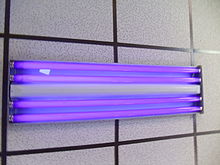
A blacklight, also called a UV-A light, Wood's lamp, or ultraviolet light, is a lamp that emits long-wave (UV-A) ultraviolet light and very little visible light.[1][2][3] One type of lamp has a violet filter material, either on the bulb or in a separate glass filter in the lamp housing, which blocks most visible light and allows through UV,[2] so the lamp has a dim violet glow when operating.[4][5] Blacklight lamps which have this filter have a lighting industry designation that includes the letters "BLB".[2][4] This stands for "blacklight blue". A second type of lamp produces ultraviolet but does not have the filter material, so it produces more visible light and has a blue color when operating.[2][3][4] These tubes are made for use in "bug zapper" insect traps, and are identified by the industry designation "BL".[4][5] This stands for "blacklight".
Blacklight sources may be specially designed fluorescent lamps, mercury-vapor lamps, light-emitting diodes (LEDs), lasers, or incandescent lamps. In medicine, forensics, and some other scientific fields, such a light source is referred to as a Wood's lamp, named after Robert Williams Wood, who invented the original Wood's glass UV filters.
Although many other types of lamp emit ultraviolet light with visible light, blacklights are essential when UV-A light without visible light is needed, particularly in observing fluorescence,[3][4] the colored glow that many substances emit when exposed to UV. They are employed for decorative and artistic lighting effects, diagnostic and therapeutic uses in medicine,[2] the detection of substances tagged with fluorescent dyes, rock-hunting, scorpion-hunting,[6] the detection of counterfeit money, the curing of plastic resins, attracting insects[3] and the detection of refrigerant leaks affecting refrigerators and air conditioning systems. Strong sources of long-wave ultraviolet light are used in tanning beds.[3]
- ^ Kitsinelis, Spiros (2012). The Right Light: Matching Technologies to Needs and Applications. CRC Press. p. 108. ISBN 978-1-4398-9931-1. Archived from the original on 2013-05-27.
- ^ a b c d e Booth, C. (1971). Methods in Microbiology. Vol. 4. Academic Press. p. 642. ISBN 978-0-08-086030-5. Archived from the original on 2013-05-27.
- ^ a b c d e Simpson, Robert S. (2003). Lighting Control: Technology and Applications. Taylor & Francis. p. 125. ISBN 978-0-240-51566-3. Archived from the original on 2013-05-27.
- ^ a b c d e "Black Lights". Technical information. Glow Inc. 2010. Archived from the original on November 16, 2018. Retrieved November 15, 2018.
- ^ a b Rorie, Benjamin (2011). "How Do Black Lights Work?". Blog. 1000Bulbs.com. Archived from the original on February 14, 2013. Retrieved January 16, 2013.
- ^ Stachel, Shawn (1999). "The fluorescence of scorpions and cataractogenesis" (PDF). Chemistry & Biology. 6 (8): 531–539. doi:10.1016/S1074-5521(99)80085-4. PMID 10421760. Archived (PDF) from the original on 2023-03-11. Retrieved 2023-01-15.